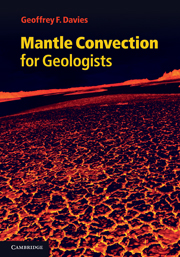Book contents
- Frontmatter
- Contents
- 1 Introduction
- 2 Context
- 3 Why moving plates?
- 4 Solid, yielding mantle
- 5 Convection
- 6 The plate mode of convection
- 7 The plume mode of convection
- 8 Perspective
- 9 Evolution and tectonics
- 10 Mantle chemical evolution
- 11 Assimilating mantle convection into geology
- Appendix A Exponential growth and decay
- Appendix B Thermal evolution details
- Appendix C Chemical evolution details
- References
- Index
7 - The plume mode of convection
Published online by Cambridge University Press: 03 May 2011
- Frontmatter
- Contents
- 1 Introduction
- 2 Context
- 3 Why moving plates?
- 4 Solid, yielding mantle
- 5 Convection
- 6 The plate mode of convection
- 7 The plume mode of convection
- 8 Perspective
- 9 Evolution and tectonics
- 10 Mantle chemical evolution
- 11 Assimilating mantle convection into geology
- Appendix A Exponential growth and decay
- Appendix B Thermal evolution details
- Appendix C Chemical evolution details
- References
- Index
Summary
How were plumes conceived? Is there evidence for plumes at the Earth's surface? Hotspot tracks. Inevitable plumes? Hotspot swells, heat and mass transport by the plume mode. Degree of melting. Favoured forms of upwelling and the role of temperature dependence of viscosity. Heads and tails – flood basalts, connecting tracks. Melt production from plume heads, and relation to flood basalts. Irregularities, misfits, puzzles and possibilities – the simple thermal model doesn't explain everything. Thermochemical plumes may account for much of the irregularity.
Scattered across the sea floor are many submarine ridges, seamounts and plateaus (Figure 2.4). These are not obviously related to plate tectonics, as are the mid-ocean ridges and deep ocean trenches. Some of these edifices reach above sea level to form islands. In Chapter 3 I recounted how Tuzo Wilson built on the observations of Darwin and Dana, who had discerned an apparent age progression along island chains in the Pacific, from volcanically active islands through eroded islands to atolls marking where an island had been eroded to sea level. The classic example is the Hawaiian island chain, shown in Figure 7.1. As well as the islands, there is a long chain of seamounts extending to the northwest. There is also a broad swell in the sea floor around the Hawaiian chain. These observations give us important information about processes in the mantle.
- Type
- Chapter
- Information
- Mantle Convection for Geologists , pp. 73 - 103Publisher: Cambridge University PressPrint publication year: 2011



